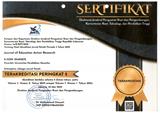Mood and Modality in Interpersonal Meaning of Joseph Robinette Biden Victory Speech
DOI:
https://doi.org/10.23887/ijerr.v6i3.68454Keywords:
Mood, Modality, SpeechAbstract
Speech involves the articulation of one's ideas and emotions. Politicians must possess the skill to effectively utilize language. Prior research underscores the significance of studying the political language, as it empowers individuals to grasp how those aspiring to attain, wield, and retain authority employ language. The purpose of this study is to analyze how mood and modality were used in the victory speech. This research applies qualitative design. The transcription of Joe Biden's victory speech is the subject of this investigation. Mr. Biden convey commitments and responsibility connected with the program that he will run; however, we don't know whether it will be run or no. This research applied qualitative research. The analysis is using data collection, data reduction, data display, and conclusion. According to the findings of this study, there are three distinct categories: value, modality, and mood. Declarative mood is the most common type; 193 clauses, or about 94%, are in the imperative mood, followed by seven clauses, or 3,4%, and three clauses, or about 1,5 percent, in the interrogative mood. The dominant modality value is median, there are eighteen provisions or around 62,1%, then, at that point, trailed by eight clauses or around 27,6% as low worth and the latter is three conditions or 10,3% for high worth. The dominant type of modality is obligation. Eleven clauses, or approximately 37.9 percent, are classified as obligation, ten clauses, or approximately 34.5%, as probability, and eight clauses, or approximately 26.7 percent, as inclination.
References
Abudayeh, H., & Dubbati, B. (2020). Politeness strategies in translating Donald Trump’s offensive language into Arabic. Perspectives: Studies in Translation Theory and Practice, 28(3), 424–439. https://doi.org/10.1080/0907676X.2019.1709514.
Al-Bantany, N. F. (2013). The Use of Commissive Speech Acts and Its Politeness Implication: A Case of Banten Gubernatorial Candidate Debate. Passage, 1(Vol 1, No 2 (2013): October Graduation 2013), 21–34. https://ejournal.upi.edu/index.php/psg/article/view/534.
Alfauzan, A., Alimni, A., Agus, K. D., Elza, T., & Adi, W. (2022). Implications of Teacher Interpersonal Communication Ability on Student Learning Motivation in Islamic Religious Education Lessons During Pandemic. Journal of Educational Research and Evaluation, 6(1), 156–167. https://doi.org/10.23887/jere.v6i1.39547.
Aryani, N. S. (2017). The politeness strategies used by the main characters of Twillight movie. In Unpublished Thesis. Yogyakarta: Sanata Dharma. Yogyakarta: Sanata Dharma University.
Ashman, G., & Snow, P. (2019). Oral Language Competence: How It Relates to Classroom Behavior. American Educator, 43(2), 37–41. https://eric.ed.gov/?id=EJ1218776.
Aytekin, C., & Sutcu, C. S. (2013). A study of twitter speech language in social media: The relation between the use of common hashtag and user profile. Proceedings of the 2nd International Symposium on Language and Communication: Exploring Novelties, Izmi, 17–19. https://www.mdpi.com/1424-8220/19/21/4654.
Carayannis, E. G., Campbell, D. F. J., & Grigoroudis, E. (2021). Democracy and the environment: How political freedom is linked with environmental sustainability. Sustainability (Switzerland), 13(10). https://doi.org/10.3390/su13105522.
Cooley, A. (2013). Qualitative Research in Education: The Origins, Debates, and Politics of Creating Knowledge. Educational Studies. https://doi.org/10.1080/00131946.2013.783834.
Costantino, M. A., & Bonati, M. (2014). A Scoping Review of Interventions to Supplement Spoken Communication for Children with Limited Speech or Language Skills. PLOS ONE, 9(3), e90744. https://doi.org/10.1371/JOURNAL.PONE.0090744.
Cummins, C., Pellicano, E., & Crane, L. (2020). Autistic adults’ views of their communication skills and needs. International Journal of Language & Communication Disorders, 55(5), 678–689. https://doi.org/https://doi.org/10.1111/1460-6984.12552.
Dementyev, V. (2016). Speech Genres and Discourse: Genres Study in Discourse Analysis Paradigm. Russian Journal of Linguistics, 20(4), 103–121. https://doi.org/10.22363/231229182220166200441033121.
Dewaele, J. M. (2004). The emotional force of swearwords and taboo words in the speech of multilinguals. Journal of Multilingual and Multicultural Development, 25(2–3), 204–222. https://doi.org/10.1080/01434630408666529.
Erawati, N. K. R., & Sulibra, I. K. N. (2017). Speech Act Verb in Old Javanese: Natural Semantics Metalanguage Analysis. International Journal of Language and Linguistics, 4(2), 71–80. https://www.academia.edu/download/99389074/9.pdf.
Faruq, Sabani, N., Sukarno, A., & Purwandari, E. (2021). Systematic Literature Review: Psychological Concepts Of Learning In Handling Speaking Delay In Early Children. Jurnal Penelitian Humaniora, 23(1), 45–54. https://doi.org/10.23917/humaniora.v23i1.19126.
Gao. C. (2013). A sociolinguistic study of English taboo language. Theory and Practice in Language Studies, 3(12), 2310. http://www.academypublication.com/issues/past/tpls/vol03/12/tpls0312.pdf.
Gregersen, S. (2020). Language death, modality, and functional explanations. Acta Linguistica Hafniensia, 52(1), 117–143. https://doi.org/10.1080/03740463.2020.1743582.
Heller, M. (2020). Code-switching and the politics of language. In The bilingualism reader. Routledge.
Miles, M. B., Huberman, A. M., & Saldana, J. (2014). Qualitative Data Analysis. Sage Publication.
Ningsih, L. F. Y. (2019). Conversation Analysis: Communication Across Cultures. Jurnal Avesina, 13(2), 29–35. https://www.e-journal.unizar.ac.id/index.php/avesina/article/view/206.
Ntoumanis, N., Quested, E., Reeve, J., & Cheon, S. H. (2017). Need-supportive communication: Implications for motivation in sport, exercise, and physical activity. Persuasion and Communication in Sport, Exercise, and Physical Activity, 19(December), 155–169. https://doi.org/10.4324/9781315624365.
Ouafeu, Y. T. S. (2006). Politeness strategies in colloquial Cameroon English: Focus on three pragmatic particles: na, ya and eihn. Nordic Journal of African Studies, 15(4), 536–544. https://doi.org/10.53228/njas.v15i4.42 Published 2006-12-31.
Pakzadian, M. (2012). Politeness principle in 2008 presidential debates between Mc Cain and Obama. Mediterranean Journal of Social Sciences, 3(3), 351–357. https://doi.org/10.5901/mjss.2012.v3n3p351.
Parina, J. C. M., & De Leon, K. D. (2014). A Stylistic Analysis of the Use of Modality: To identify the Point of View in a Short Story. 3L: Language, Linguistics, Literature, 20(2), 91–101. https://doi.org/10.17576/3L-2014-2002-08.
Sabanci, A., Sahin, A., Sonmez, M. A., & Yilmaz, O. (2016). School Managers ’ Interpersonal Communication Skills in Turkey. International Journal of Academic Research in Business and Social Sciences, 6(8), 13–30. https://doi.org/10.6007/IJARBSS/v6-i8/2021.
Shanks, J. D., Izumi, B., Sun, C., Martin, A., & Shanks, C. B. (2017). Teaching undergraduate students to visualize and communicate Public Health data with infographics. Frontiers in Public Health, 5(NOV), 1–6. https://doi.org/10.3389/fpubh.2017.00315.
Sholihah, A. (2020). The Dominant Errors of Speech Production Committed in Speaking Class Interaction. Pedagogy : Journal of English Language Teaching, 7(2), 136–144. https://doi.org/10.32332/pedagogy.v7i2.1671.
Sibarani, J. G., & Marlina, L. (2018). Politeness Strategy used in Republican Debate by Donald trump. E-Journal of English Language & Literatyre, 7(4), 531–535. https://doi.org/10.24036/ell.v7i4.102007.
Suwastini, N. K. A., Asri, N. W. D. P., Wahyuni, L. G. E., & Prastika, K. A. D. (2020). The Characterisations of Piscine Molitor Patel in Yan Martell’S the Life of Pi. International Journal of Language and Literature, 4(2), 56. https://doi.org/10.23887/ijll.v4i2.30289.
Vicheanpant, T., & Ruenglertpanyakul, W. (2012). Attitude about project-based learning and lecture based for develop communication skill. European Journal of Social Sciences, 28(4), 465–472. https://www.scirp.org/journal/paperinformation.aspx?paperid=116507.
Williams, H. (2021). The meaning of “Phenomenology”: Qualitative and philosophical phenomenological research methods. Qualitative Report. https://doi.org/10.46743/2160-3715/2021.4587.
Downloads
Published
How to Cite
Issue
Section
License
Copyright (c) 2023 Devi Sari Panggabean, T. Silvana Sinar, Nurlela

This work is licensed under a Creative Commons Attribution-ShareAlike 4.0 International License.
Authors who publish with the Indonesian Journal of Educational Research and Review (IJERR) agree to the following terms:
- Authors retain copyright and grant the journal the right of first publication with the work simultaneously licensed under a Creative Commons Attribution License (CC BY-SA 4.0) that allows others to share the work with an acknowledgment of the work's authorship and initial publication in this journal.
- Authors are able to enter into separate, additional contractual arrangements for the non-exclusive distribution of the journal's published version of the work (e.g., post it to an institutional repository or publish it in a book), with an acknowledgment of its initial publication in this journal.
- Authors are permitted and encouraged to post their work online (e.g., in institutional repositories or on their website) prior to and during the submission process, as it can lead to productive exchanges, as well as earlier and greater citation of published work. (See The Effect of Open Access)












